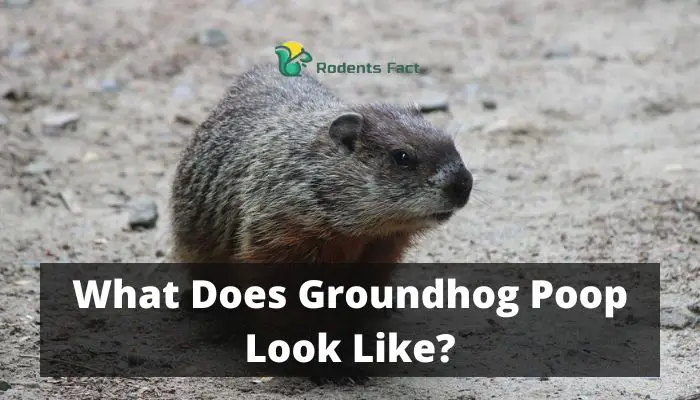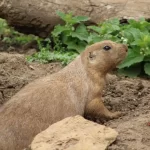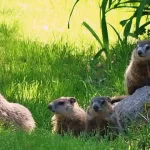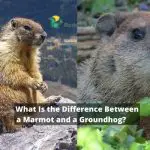What Does Groundhog Poop Look Like? The Unknown and Weird Facts
Regarding animals, there is no question that people are fascinated by their excrement. Whether it’s because of the smell, the texture, or the sheer volume, there is something about animal feces that captures our attention. So, what does groundhog poop look like?

As it turns out, groundhog poop is pretty similar to human feces. It is usually dark in color and has a soft, squishy consistency. However, a few key differences set it apart from human poop. For one thing, groundhog poop is much smaller in size.
And, because groundhogs are herbivores, their poop does not contain any undigested food particles. We did some research and found out that groundhog poop looks a lot like mouse droppings. They’re small and have a similar shape, but groundhog droppings are usually darker in color.
How Does the Poop of a Groundhog Look Like?
Rodents like groundhogs share various characteristics, including the size and form of their scat. Like many other rodents, these creatures’ digestive waste is dry, tiny, and round. Colors differ significantly from one another.

Other rodents, like squirrels, can produce black excrement, but this one is dark brown.
Where Do Groundhogs Poop?
Woodchucks poop underground. According to scientists, they have a restroom place within their labyrinth of tunnels. Groundhogs have been known to dig tunnels up to three or four feet deep and their substantial burrow systems.
Is Groundhog Poop Dangerous?
Groundhog poop is usually harmless and can be composted, but there have been cases where it has caused illness. However, there is always the potential for ingesting something harmful if it is not adequately cleaned.

Additionally, groundhog poop can sometimes contain parasites, which can be harmful if swallowed. Talk to your doctor if you are concerned about whether or not groundhog poop is dangerous like groundhog itself (hardly).
Dangers of Groundhogs Poop
Although most households won’t have to deal with groundhog droppings, rabid groundhogs may act abnormally and spit out in the open. However, contact with groundhog scat cannot spread the illness to people since rabies must be transferred through saliva or nervous system tissue.
For safe and effective eradication of groundhog or other burrowing animal infestations, residents should call their local pest management experts, especially if they have reason to believe the pests are rabid.

It is an infectious illness that frequently targets the skin, eyes, lymph nodes, and lungs. The Francisella tularensis bacteria is the source of tularemia.
Groundhogs receive this from insects that humans can catch by touching groundhog scat.
If you are confused about the rarity of the black squirrel, you can go through our blog, How Rare Are Black Squirrels?
Usage of Groundhog Poop

The majority of animal feces are useless waste products. Animals seldom emit metabolic waste that has a commercial use, like fertilizer. Groundhogs belong to a completely distinct class. You also need groundhog feces to catch a groundhog.
Amazingly, groundhogs can be attracted to and caught by woodchuck dung. Yes, utilizing scats of the same species is the most effective approach to catching these enormous rodents.
The woodchuck lives underground, making it challenging to locate or capture. Because of this, it is advisable to lure them outside and catch them there. Because of this circumstance, getting their scat is much more valuable. Yes, that part is also challenging.
What Do Groundhogs Do to Their Poop?
Groundhogs use underground tunnels to eliminate their metabolic waste. That is a highly advanced method of animal waste disposal.
Many people used to think that after excreting, groundhogs buried their waste. However, research revealed that these mighty rodents go to certain spots underground to urinate.

The fact that the groundhogs themselves dig these tunnels is astonishing.
It is not simply a poop-filled ditch, either. To avoid threats, it is often a large tunnel with several chambers. Despite their problems and destructive personalities, this characteristic demonstrates that groundhogs are clean creatures.
Additional Read: Why Do Beavers Have Red Teeth?
Infestation Symptoms
Although the pests destroy lawns by devouring garden plants and digging holes, they are generally clean creatures. Groundhogs excrete in specialized subterranean tunnels, so homeowners seldom see their waste.

Those who discover garbage and burrows on their land may have insect infestations of many kinds. Skunks, badgers, and prairie dogs all create holes of comparable size, but they do not bury their waste.
Additionally, groundhogs are known to reside under patios, staircases, and foundations.
The following video shows how groundhog poops:
Frequently Asked Question
What kind of poop Do groundhogs have?
Groundhogs have medium-sized, oval-shaped, often dark brown or black droppings, like other rodents.
Final Words
We hope you got an answer regarding “what does groundhog poop look like?”
Due to the large amount of detritus that makes up the furry animal, scientists estimate that a groundhog can poop 2 to 4 times more than the average bear, depending on the species.
It’s conceivable to have one of these animals in the neighborhood for months and not locate their feces anywhere since they are so clean.
If you want groundhog feces, you need a groundhog. To catch a groundhog, you also need groundhog dung. That is not confusing at all.




